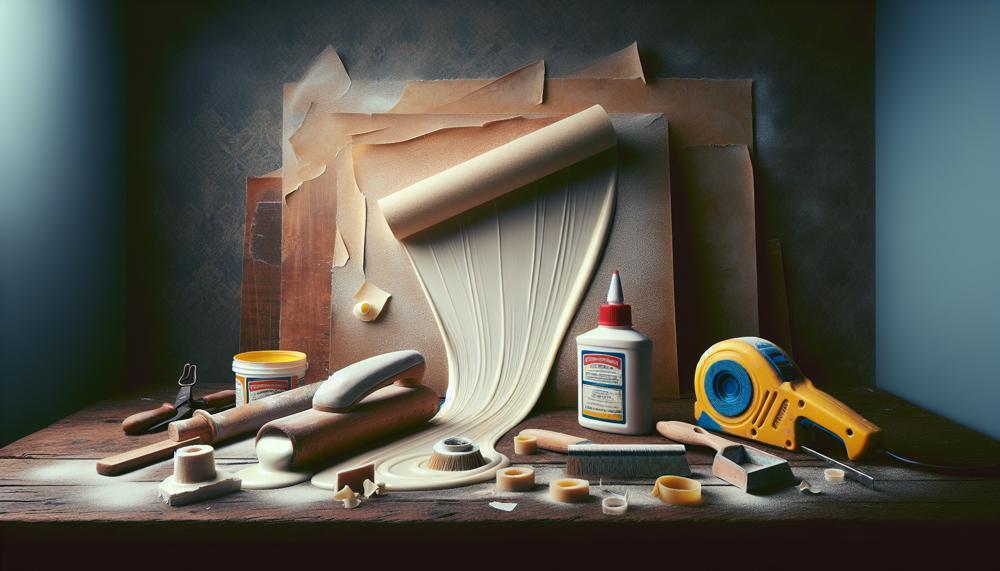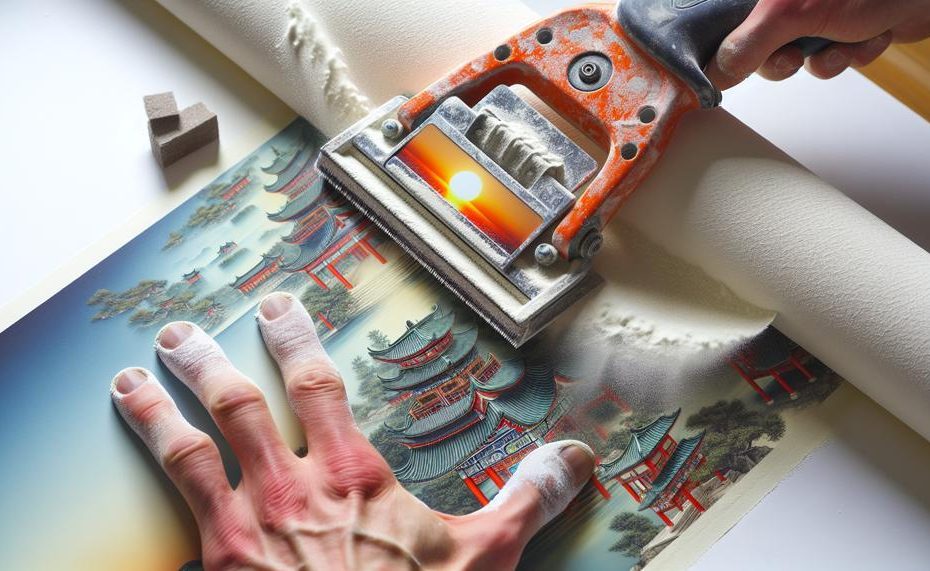Are you fed up with the sight of peeling, outdated wallpaper in your home? Are you finally ready to bid farewell to it once and for all? We understand the struggle of dealing with stubborn wallpaper glue that seems impossible to remove. We have all the inside information you need to successfully eliminate that pesky residue.
So, can you sand wallpaper glue off?
Yes, you can sand wallpaper glue off. Sanding is an effective way to remove stubborn adhesive. Here are some steps for sanding wallpaper glue:
- Place the sandpaper on a sanding block.
- Use a back and forth motion to sand the adhesive away from the surface.
- Replace the sandpaper when it wears out.
- Wipe the wall down with a wet rag as you go.
- Allow the wall to dry completely.
- Wipe away the dust from your walls with a cloth and some soapy water.
You can use medium-grit or fine-grit sandpaper. If the glue is very thick, you can start with the medium-grit sandpaper and then move to the fine-grit sandpaper.
Sanding can be an option, but if it’s thick, it can be a challenge. Sanding can come off in a fine powder, but it kicks off a lot of dust.
Let’s get started.
Contents
Best Sandpaper for Wallpaper Glue
The ideal sandpaper for removing wallpaper glue is medium or fine grit. This type of sandpaper is perfect for walls as it minimizes scratches and blemishes while effectively eliminating the glue. Furthermore, using a pole sander with 100 grit sandpaper is a safe and efficient technique for removing wallpaper glue from walls.
Using a pole sander with 100 grit sandpaper allows for better control and reach while sanding. It is crucial to clean the surface with a cloth before sanding to loosen the glue. However, it is essential to avoid using water or other substances during the process as they can cause damage.
A table summarizing the recommended method for removing wallpaper glue using sandpaper is provided below:
| Step | Description |
|---|---|
| 1 | Clean the surface with a cloth to loosen the glue |
| 2 | Use a pole sander with 100 grit sandpaper for better control and reach |
| 3 | Test the pole sander on a small area of drywall before use |
| 4 | Sand the walls in sections, moving in one direction |
| 5 | Fill any leftover spots with drywall mud for a smooth finish |
By following these steps, you can remove wallpaper glue in seconds, leaving behind a smooth surface ready for painting or new wallpaper application. Just remember not to paint over any remaining wallpaper glue as it can cause unwanted reactions and ruin the finish.
Steps On How To Sand Wallpaper Glue Safely

When preparing to sand off wallpaper glue from your walls, it is crucial to take the necessary safety precautions to avoid any potential hazards or damages.
Here are some key measures to keep in mind:
- Don protective gear: Before commencing the sanding process, ensure you wear protective gear such as a dust mask, safety goggles, and gloves to shield yourself from dust and debris.
- Prepare the area: Lay down drop cloths or plastic sheets to safeguard your floors and furniture from any potential damage or debris.
- Use the appropriate tools: Utilize a pole sander with medium or fine grit sandpaper to prevent damaging the wall or creating excessive dust.
- Test the sander: Before embarking on sanding the entire wall, test the pole sander on a small area of drywall to ensure it is properly equipped and will not cause any damage.
- Sand evenly: Ensure you sand the entire surface evenly to prevent leaving behind any glue or producing an uneven finish.
- Fill any remaining spots: If there are any leftover spots of glue after sanding, fill them with drywall mud to prevent any compromise and maintain a smooth finish.
- Avoid painting over wallpaper glue: It is not advisable to paint over wallpaper glue as it may react with water-based paint and ruin the finishing. Make sure all glue has been removed before painting.
- Take breaks: Sanding can be a tiring and time-consuming process, so make sure to take breaks and pace yourself to avoid fatigue.
- Inspect the walls after sanding: After completing the sanding process, visually inspect the walls to ensure all the glue has been removed for a smooth finish.
How To Tell If Wallpaper Glue Is Removed
Before attempting to sand off wallpaper glue, it is imperative to ensure that all traces of the adhesive have been completely removed.
Here are some ways to determine if the glue has been successfully eliminated:
Employ the Spray and Check Technique
This method involves spraying water on the wall and running your hand or putty knife down to feel for any stickiness.
If the wall feels smooth and there is no residue on your hand or knife, then the glue has been successfully removed.
Inspect Under Adequate Lighting
Another way to check for any leftover glue is by inspecting the wall under adequate lighting.
Natural light or a bright lamp can help identify any remaining spots of glue that may have been overlooked.
Check the Back of Removed Wallpaper
The back of the removed wallpaper can also be examined for any remaining adhesive.
If there is still glue present, it must be removed before sanding.
Test with a Towel
After removing the wallpaper and using a wet sponge to wipe away any excess glue, use a towel to dry and test if any glue remains.
If the towel sticks or pulls away any residue, then it needs to be removed before sanding.
Is It OK To Paint Over Wallpaper Glue?
No, it’s not advised to sand off wallpaper glue before painting over it.
Trying to sand off the glue can potentially cause harm to the walls and may not effectively remove all of the adhesive.
Why Does Wallpaper Glue Get Stuck?
Wallpaper glue can become stubbornly stuck and challenging to remove for a multitude of reasons. These include high levels of humidity, subpar glue quality, air bubbles forming during installation, contaminations in the plaster, and even mold growth on walls.
These factors can all contribute to the adhesive behind the wallpaper becoming difficult to remove.
In some cases, it may even be necessary to completely strip the wallpaper and start fresh in order to properly remove the stubborn glue.
- Humidity: When there is excess moisture in the air, it can activate the wallpaper glue and make it much harder to remove. This is especially prevalent in areas with poor ventilation or high humidity levels, such as bathrooms.
- Poor quality glue: Using low-quality wallpaper glue can also lead to it becoming stuck and difficult to remove. Inferior glue may not have enough adhesive power to properly stick the wallpaper, resulting in bubbles or wrinkles that can make it harder to remove without causing damage.
- Bubbles during installation: Proper installation of wallpaper requires careful attention to smoothing out any bubbles or wrinkles that may appear. If these are not addressed properly, they can create air pockets between the wallpaper and wall, leading to the glue becoming stubbornly stuck.
- Impurities in plaster: If there are impurities in your plaster or wall surface, these can affect the adhesive power of wallpaper glue. This can cause it to become stuck and difficult to remove, as well as potentially damaging the walls when attempting to peel off the wallpaper.
- Fungus growth on walls: Mold or fungus growth on walls can also contribute to wallpaper glue becoming stuck and challenging to remove. The fungus can penetrate through the wallpaper and affect the adhesive, making it harder to peel off without causing damage.
Conclusion
In conclusion, taking off wallpaper adhesive might seem like a difficult undertaking, but if you have the correct equipment and know-how, you can bid adieu to that tenacious residue and welcome to a brand-new aesthetic for your walls.
With the necessary supplies and equipment at your disposal, as well as a detailed instruction manual for a smooth removal, you are now fully prepared to tackle wallpaper glue. We’ve also provided advice on how to prevent typical blunders and other techniques for handling difficult glue areas.
When sanding off wallpaper glue, keep in mind that safety comes first. Also, before painting over any leftover adhesive, make sure there is none left. You may obtain a perfect finish without harming your walls by following these procedures.





